 | |||||||||||||||
go to
ARCHIVE
for topics on
all the days.
2011
feb days
• van gogh's tarnished paints
ARCHIVE
2010
nov days
• surplus store camouflage gear
aug days
• greener, whiter, redder vegetables
jun days
• french & american recycled colored plastic
may days
• gray walk through sunny oakland
apr days
• color
concept &
theory widgets and apps
mar days
• red:
a portrait of a artist rothko
feb days
• talking
heads as figure/ground
jan days
• tanja's
black light dance party
dec days
• tootsie roll pop wrappers colors & flavors
nov days
• stephen vitiello's four color sound
oct days
• atmospheric perspective
sept days
• a rainbow
of antioxidants
colors
aug days
• floor stain colorants
jul days
• minimal colors
jun days
• wildflowers cataloged by color
may days
• tennis court colors
apr days
• morandi's neutral colors
mar days
• grid colorists
feb days
• black as
film noir
jan days
• flood of toxic minerals used in paints
ARCHIVE
2008
dec days
• comple-mentary
colors
nov days
• kettle korn
packaging color change
oct days
• green fluorescent protein
sept days
• red palms - not green
aug days
• blue tunes
jul days
• “blue” - textile museum
jun days
• “fiesta- ware”
colorants
may days
• “blue alchemy” hive gallery
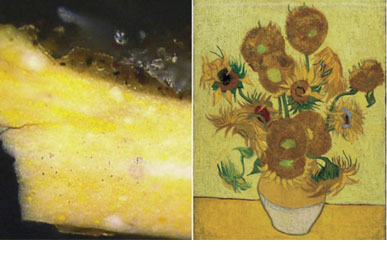
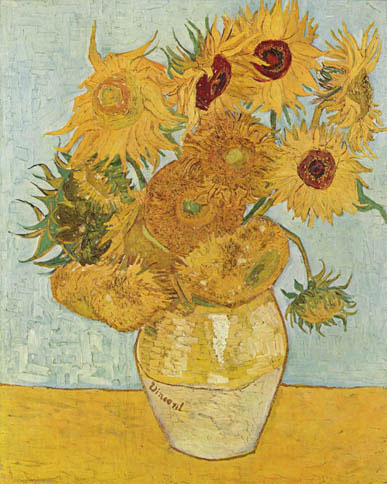
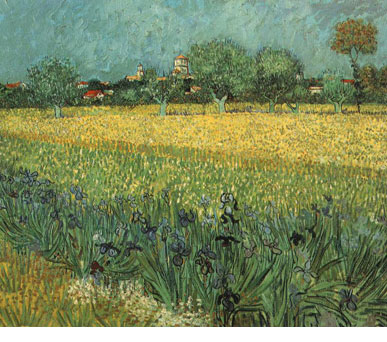
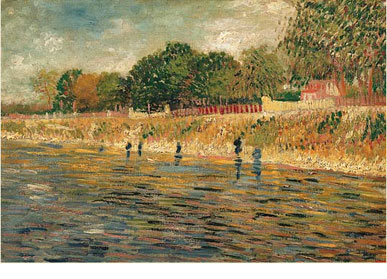
van gogh's tarnished paints
A sample (far left) taken from Van Gogh's Bank of the Seine studied with synchrotron X-rays and (near left) Van Gogh's Sunflowers painted in 1888 – Photo: PA
The following articles describe why Van Gogh's use of vibrant, chrome yellow becomes altered to a deep brown tone.
Article by Andy Bloxham
The Telegraph
Feb 2011
Van Gogh's yellow sunflowers 'are turning brown'
Chemical changes in a yellow pigment favoured by Vincent van Gogh have taken some of the shine out of the artist's famous sunflowers, scientists have discovered.
The findings, from a study of samples from two van Gogh paintings, may lead to new ways of preserving or
restoring old masters.
Van Gogh's use of bright colours shaped the vibrant mood of his works and marked a major milestone in the history of art.
He loved the chrome yellow pigment that gave his "sunflower" paintings such intensity. But since the early 19th century it has been known that chrome yellow is affected by sunlight, darkening to a brown shade over time.
New analysis using sophisticated X-ray techniques has now identified the cause of the problem, a "reduction"
reaction that alters the chromium in the paint.
Scientists tested samples taken from two paintings,
View of Aries with Irises (1888) and Bank of the Seine (1887), which are both on display at the Van Gogh Museum in Amsterdam.
Paintings by Van Gogh on the left:
View of Aries with Irises (1888) and Bank of the Seine (1887),
see article below on left
By Richard Alleyne
Science Correspondent
Article By Richard Alleyne, Science Correspondent
BBC News / 14 Feb 2011
The Dutch painter was pioneering in his use of ultra-bright colours designed to represent mood and emotion rather than be realistic depictions of his subjects. But his use of industrial paint known as chrome yellow, often mixed with white, to achieve this effect, means that some have faded over time.
Now scientists have unlocked the reason and hope that it could halt further decline and even reverse some of the damage caused to the multi-million pound artwork. The discovery, revealed in the journal Analytical Chemistry, was made by an international team of scientists led by Professor Koen Janssens of Antwerp University in Belgium. They used a two-step approach.
RELATED ARTICLES
Van Gogh's yellow sunflowers 'are turning brown' 15 Feb 2011.
First, they collected samples from three leftover historic paint tubes and artificially aged them for 500 hours using an UV-lamp.
Only one sample, from a paint tube belonging to the Flemish Fauvist Rik Wouters showed significant darkening. Within three weeks, its surface of originally bright yellow had become chocolate brown.
Using a powerful x-ray machine they discovered that the artificial sunlight had caused the chromium in the chrome yellow to reduce from Chromium six (Cr (VI)) to Chromium three
(Cr (III))
In the second step, the scientists used the same methods to examine samples from affected areas of two Van Gogh paintings, View of Arles with Irises (1888) and Bank of the Seine (1887), both on display in the Van Gogh Museum in Amsterdam.
The results indicate that the reduction reaction from Cr (VI) to Cr (III) is likely to also have taken place in the two Van Gogh paintings.
Based on this observation, the scientists speculate that Van Gogh's technique of blending white and yellow paint might be the cause of the darkening of his yellow paint.
Prof Janssens said: "Obviously, we want to understand which conditions favour the reduction of chromium, and whether there is any hope to revert pigments to the original state in paintings where it is already taking place." Until then the team recommend that paintings are kept out of the Sun.
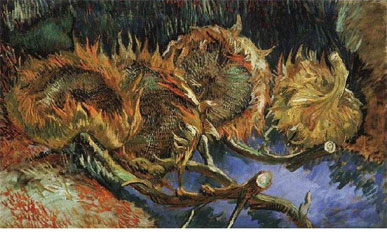

Sunflowers in Vase 1887
Sunflowers on Table 1888